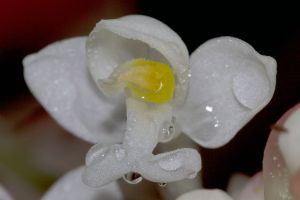No edit summary Tag: wikieditor |
|||
| Line 10: | Line 10: | ||
From India to Indonesia and S. E. Asia is the home of this hot to warm growing 'jewel orchid', so called because of their dark green leaves criss-crossed with red lateral lines, that makes them quite appealing even when not in bloom, which is interesting but not fantastic. This species is a terrestrial or lithophytic plant occurring in evergreen, lowland forests in shady, humid habitats with rocky substrates along streams and rivers without pseudobulbs, the fleshy red stems twisted, erect or pendulous are 20cm to 25cm long and have stalked elliptic-lanceolate 5cm to 7.5cm leaves and blooms in the spring on a terminal cylindrical fairly dense 10cm to 30cm long inflorescence that has small asymetrical, fragrant flowers that last 2 to 3 weeks. They can be potted with 50% potting soil and 50% tree bark, given deep shade and humid well watered conditions year round. If the leaves lose the dark green and a lot of pale red is visible they are getting too much light. | From India to Indonesia and S. E. Asia is the home of this hot to warm growing 'jewel orchid', so called because of their dark green leaves criss-crossed with red lateral lines, that makes them quite appealing even when not in bloom, which is interesting but not fantastic. This species is a terrestrial or lithophytic plant occurring in evergreen, lowland forests in shady, humid habitats with rocky substrates along streams and rivers without pseudobulbs, the fleshy red stems twisted, erect or pendulous are 20cm to 25cm long and have stalked elliptic-lanceolate 5cm to 7.5cm leaves and blooms in the spring on a terminal cylindrical fairly dense 10cm to 30cm long inflorescence that has small asymetrical, fragrant flowers that last 2 to 3 weeks. They can be potted with 50% potting soil and 50% tree bark, given deep shade and humid well watered conditions year round. If the leaves lose the dark green and a lot of pale red is visible they are getting too much light. | ||
Latest revision as of 15:58, 11 June 2024


Common Name: The Jewel Orchid, The Differently Colored Ludisia
Scented: yes
Light Requirements: deep shade
Temperature Requirements: intermediate to hot
Blooms: late winter through summer
Flower Size: to 1.7cm
Synonyms: Anoectochilus dawsonianus H.Low ex Rchb.f. 1868; Anoectochilus ordeanus Jennings 1875; Gonogona discolor Link 1822; *Goodyera discolor Ker-Gawl. 1816; Goodyera ordeana (Jennings) Boxall ex Náves in F.M.Blanco 1880; Goodyera rodigasciana L.Linden 1886; Goodyera rubrovenia B.S.Williams 1862; Haemaria dawsoniana (H.Low ex Rchb.f.) Hasselb. in L.H.Bailey 1915; Haemaria discolor [Ker-Gawl.]Lindley 1840; Haemaria discolor var. concolor Ridl 1896; Haemaria discolor var. condorensis Gagnep. 1934; Haemaria discolor var. dawsoniana (H.Low ex Rchb.f.) B.S.Williams 1894; Haemaria discolor var. denisoniana Kerch. 1894; Haemaria discolor var. grandis Gagnep. 1934; Haemaria discolor var. ordeana (Jennings) B.S.Williams 1894; Haemaria discolor var. rhodoneura Schltr. 1913; Haemaria discolor var. trilineata Schltr. 1913; Haemaria otletae Rolfe 1891; Haemaria pauciflora Gagnep. 1933; Haemaria rubrovenia (B.S.Williams) Rchb.f. ex Stein 1891; Ludisia dawsoniana (H.Low ex Rchb.f.) Aver. 1988; Ludisia furetii Blume 1858; Ludisia odorata Blume 1859; Ludisia otletae (Rolfe) Aver. 1988; Myoda rufescens Lindley 1832; Neottia discolor (Ker Gawl.) Steud. 1821; Orchiodes discolor (Lindl.) Kuntze 1891
From India to Indonesia and S. E. Asia is the home of this hot to warm growing 'jewel orchid', so called because of their dark green leaves criss-crossed with red lateral lines, that makes them quite appealing even when not in bloom, which is interesting but not fantastic. This species is a terrestrial or lithophytic plant occurring in evergreen, lowland forests in shady, humid habitats with rocky substrates along streams and rivers without pseudobulbs, the fleshy red stems twisted, erect or pendulous are 20cm to 25cm long and have stalked elliptic-lanceolate 5cm to 7.5cm leaves and blooms in the spring on a terminal cylindrical fairly dense 10cm to 30cm long inflorescence that has small asymetrical, fragrant flowers that last 2 to 3 weeks. They can be potted with 50% potting soil and 50% tree bark, given deep shade and humid well watered conditions year round. If the leaves lose the dark green and a lot of pale red is visible they are getting too much light.